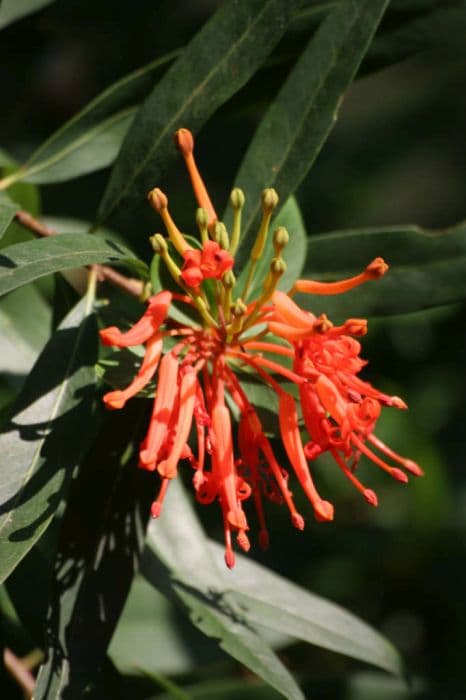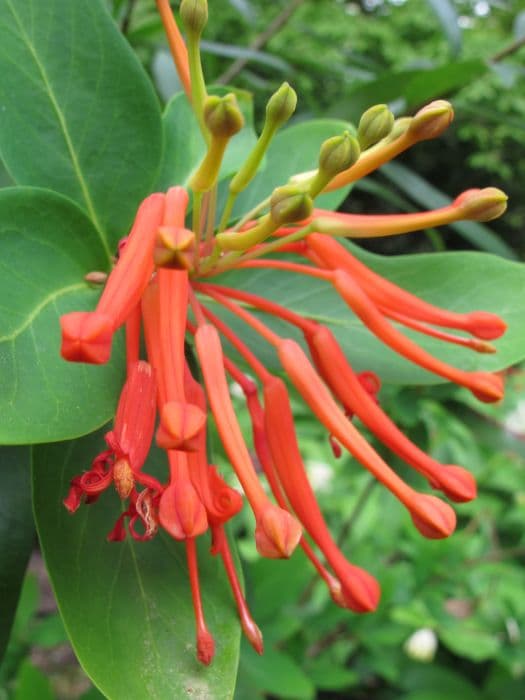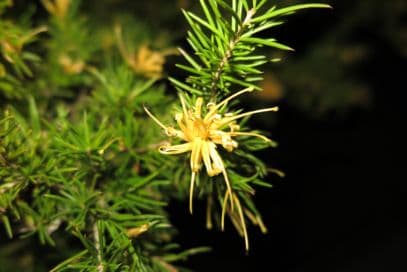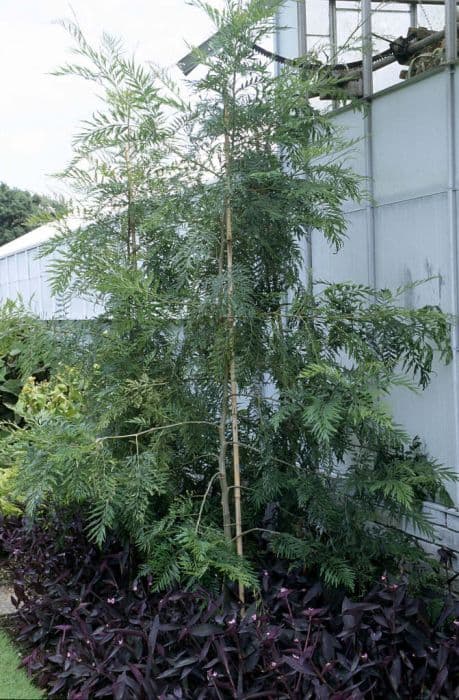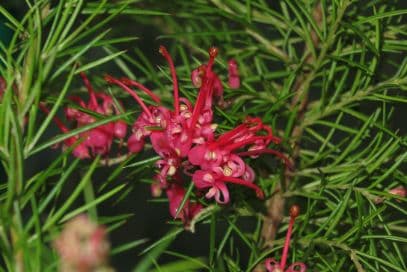Johnson's Grevillea Grevillea johnsonii

ABOUT
The Grevillea johnsonii, commonly known as Johnson's Grevillea, is an attractive and unique Australian native plant. It boasts an evergreen foliage composed of long, narrow leaves that are dark green on the top and lighter underneath. The leaves are quite distinctive with their slightly curved shape and a smooth, leathery texture. Johnson's Grevillea is perhaps best known for its stunning flowers, which typically bloom in clusters. The flowers are long and cylindrical, with a curved appearance, looking somewhat like a toothbrush. These striking blooms come in shades of pink and red, occasionally with hints of orange, which stands out against the dark green of the leaves. The flowers are rich in nectar, making them a popular choice for attracting birds and insects, particularly honeyeaters. The plant's overall structure is somewhat sprawling, with branches that can spread out gracefully. It creates a bushy appearance that's dense and lush, contributing to its appeal as a garden plant for those looking to add texture and color to their landscape design.
About this plant
 Names
NamesFamily
Proteaceae.
Synonyms
Johnson's Grevillea, New South Wales Grevillea.
Common names
Grevillea johnsonii
 Characteristics
CharacteristicsLife cycle
Perennials
Foliage type
Evergreen
Color of leaves
Green
Flower color
Mixed
Height
10 feet (3 meters)
Spread
6 feet (1.8 meters)
Plant type
Shrub
Hardiness zones
9
Native area
Australia
Benefits
 General Benefits
General Benefits- Attracts Wildlife: Grevillea johnsonii, commonly known as the Johnson's Grevillea, is known for attracting birds and bees to the garden due to its nectar-rich flowers.
- Drought Tolerance: Johnson's Grevillea has a notable ability to withstand periods of low water availability, making it suitable for drought-prone areas.
- Landscape Aesthetics: With its distinctive large red and pink flowers and attractive foliage, it adds visual interest and aesthetic value to landscapes and gardens.
- Minimal Maintenance: Once established, this plant requires relatively low maintenance, which is beneficial for those seeking a garden with less intensive care needs.
- Erosion Control: Its root system helps stabilize slopes and prevent soil erosion, especially in areas with dry soil conditions.
- Habitat Restoration: It can be used in habitat restoration projects as it is indigenous to Australia and contributes to the natural ecosystem.
- Privacy Screen: The dense foliage of Grevillea johnsonii can provide a natural privacy screen in gardens and outdoor spaces.
 Medical Properties
Medical PropertiesThis plant is not used for medical purposes.
 Air-purifying Qualities
Air-purifying QualitiesThis plant is not specifically known for air purifying qualities.
 Other Uses
Other Uses- Grevillea johnsonii wood can be utilized in small woodworking projects, such as making decorative items like picture frames or jewelry, due to its fine grain and the potential for a polished finish.
- The plant's unique flower structure can serve as an educational tool for botany enthusiasts to study the specialized pollination mechanisms involving birds.
- Grevillea johnsonii branches might be used by florists who seek exotic and long-lasting greenery for their floral arrangements.
- The shrub can be cultivated for use in themed gardens such as Australian native gardens or dryland gardens, showcasing the plant's ability to adapt to arid environments.
- Dried Grevillea johnsonii flowers can be used in the creation of natural potpourris that bring a slice of the Australian wilderness indoors.
- Landscapers can employ Grevillea johnsonii as a screen plant to provide privacy, due to its dense foliage and tall growing habit.
- This plant can be introduced into re-vegetation projects to help stabilize soil and encourage biodiversity in areas impacted by construction or erosion.
- Grevillea johnsonii can be used in butterfly and bee gardens to attract and provide nectar for a variety of pollinators due to its rich, nectar-producing flowers.
- The plant has potential for use in sound barrier vegetation due to its dense growth, helping to reduce noise pollution when planted in large numbers along highways or busy roads.
- Bird watchers may plant Grevillea johnsonii as a way to attract native bird species such as honeyeaters, which are attracted to the plant's nectar and provide delightful observation opportunities.
Interesting Facts
 Feng Shui
Feng ShuiThe Grevillea is not used in Feng Shui practice.
 Zodiac Sign Compitability
Zodiac Sign CompitabilityThe Grevillea is not used in astrology practice.
 Plant Symbolism
Plant Symbolism- Resilience: Grevillea johnsonii often grows in harsh environments, symbolizing the ability to withstand challenging conditions and adapt to adversity.
- Diversity: As part of the diverse Grevillea genus, the Johnson's Grevillea illustrates the wide range of forms and adaptations in nature, representing diversity and variety in life.
- Protection: The plant’s unique flowers with long styles can be seen as symbolizing a protective nature, perhaps due to the way these flowers offer nectar to birds while protecting their reproductive parts.
- Australian Beauty: Native to Australia, the Johnson's Grevillea symbolizes the natural beauty and unique flora that the Australian landscape offers.
 Water
WaterJohnson's Grevillea requires deep watering to maintain a healthy root system; water it deeply every two weeks, providing about 1 to 1.5 gallons per session during the growing season. In the cooler months, reduce the frequency to once a month, ensuring the soil partially dries out between watering sessions. It's important to avoid overwatering, as this can lead to root rot. During periods of extended heat or drought, keep an eye on the soil moisture and water more frequently if necessary.
 Light
LightJohnson's Grevillea thrives in a spot with full sun exposure for optimal growth and flowering. Place it in a location where it will receive at least 6 hours of direct sunlight each day to ensure it gets enough light. Avoid deeply shaded areas as this can hamper its development and reduce its vibrant blossoms.
 Temperature
TemperatureJohnson's Grevillea prefers a temperate climate and can tolerate a temperature range from about 20°F to 100°F, with an ideal range being 50°F to 85°F. It can withstand light frosts but should be protected from severe cold snaps that drop below 20°F.
 Pruning
PruningPruning Johnson's Grevillea helps maintain its shape and encourages denser growth. Prune lightly after flowering finishes, removing any dead or wayward branches to promote new growth. Pruning can be done annually, typically in late winter or early spring, to prepare the plant for the upcoming growing season.
 Cleaning
CleaningAs needed
 Soil
SoilJohnson's Grevillea thrives in a well-draining, sandy or gritty mix, slightly acidic to neutral pH around 5.5 to 7.0. A combination of regular potting soil with additional perlite and coarse sand will ensure proper drainage and aeration for the roots.
 Repotting
RepottingJohnson's Grevillea should be repotted every 2-3 years as they grow, during the spring. Ensure minimal root disturbance during the process to avoid stress on the plant.
 Humidity & Misting
Humidity & MistingJohnson's Grevillea prefers moderate humidity levels but is quite adaptable. It can handle low humidity environments typical of most homes without issues.
 Suitable locations
Suitable locationsIndoor
Place Johnson's Grevillea in bright, indirect light indoors.
Outdoor
Plant Johnson's Grevillea in full sun and protect from harsh winds.
Hardiness zone
9-11 USDA
 Life cycle
Life cycleThe Johnson's Grevillea (Grevillea johnsonii) begins its life cycle as a seed, which germinates in warm, moist soil conditions commonly after a fire or soil disturbance has occurred, breaking seed dormancy. Seedlings establish a strong root system and develop juvenile foliage, differing in shape from adult leaves. As the plant matures, it develops into a woody shrub with distinct adult foliage, and flower buds form, typically in the spring. The striking red to pink flowers, attractive to birds and insects, bloom and facilitate cross-pollination. Following pollination, the flowers develop into woody follicles that contain seeds, which are eventually released to start the next cycle. Grevillea johnsonii can live for several decades, during which it will continue to flower annually, contributing to habitat biodiversity and providing food for pollinators.
 Propogation
PropogationPropogation time
Spring to summer
The most popular method of propagating the Grevillea johnsonii, commonly known as Johnson's Grevillea, is through semi-hardwood cuttings. This involves selecting a healthy, non-flowering stem that has started to mature but is not yet fully hardened. Cuttings should be taken during the late summer to ensure optimal root development. The cuttings are typically 4 to 6 inches (about 10 to 15 centimeters) long with leaves removed from the lower half to prevent excess moisture loss. These cuttings benefit from being dipped in a rooting hormone before being planted in a well-draining potting mix. The cuttings should be kept moist and in a well-lit, warm area but out of direct sunlight until roots have developed. This process usually takes a number of weeks, after which the young plants can be transferred to individual pots and eventually planted out.
